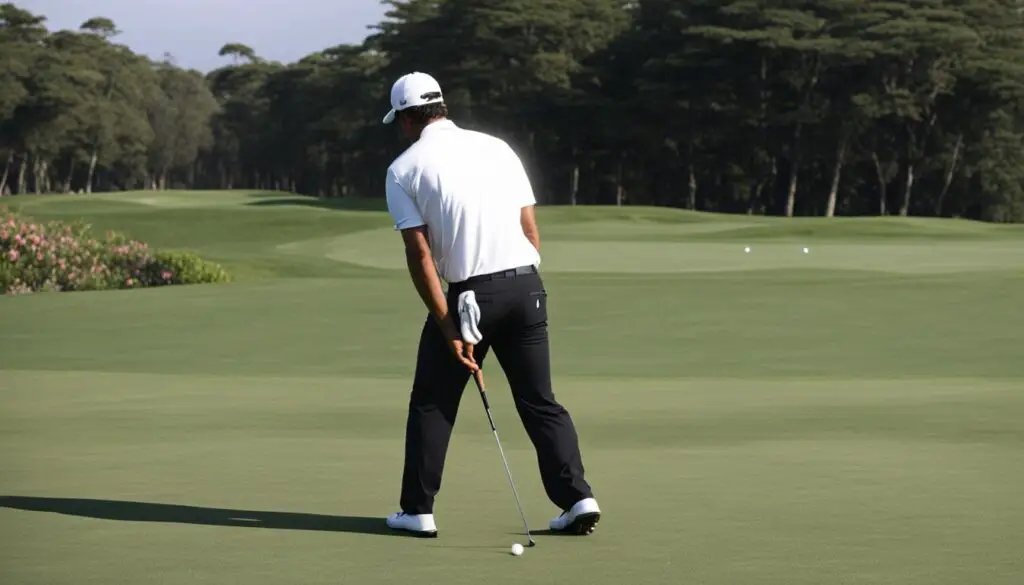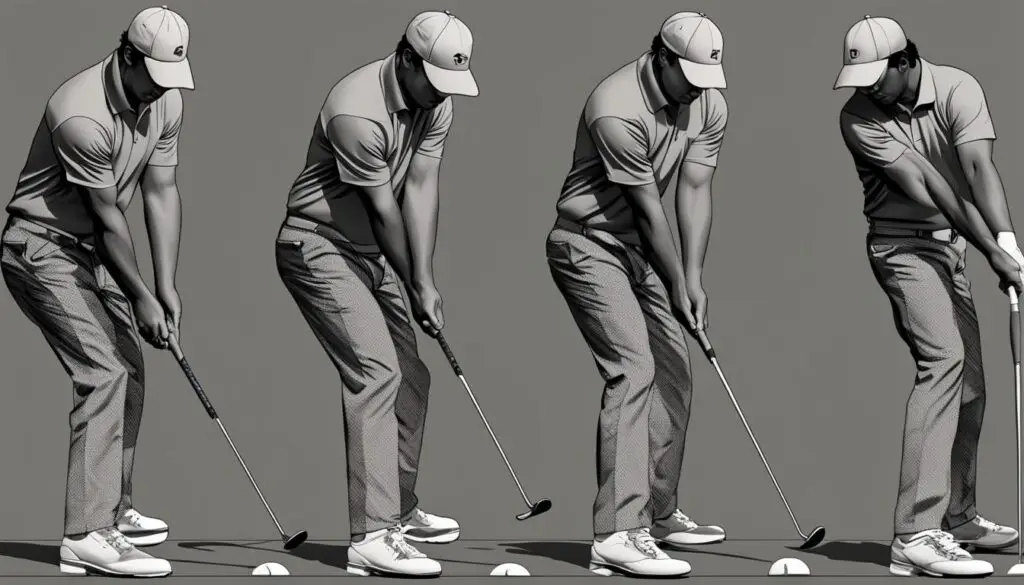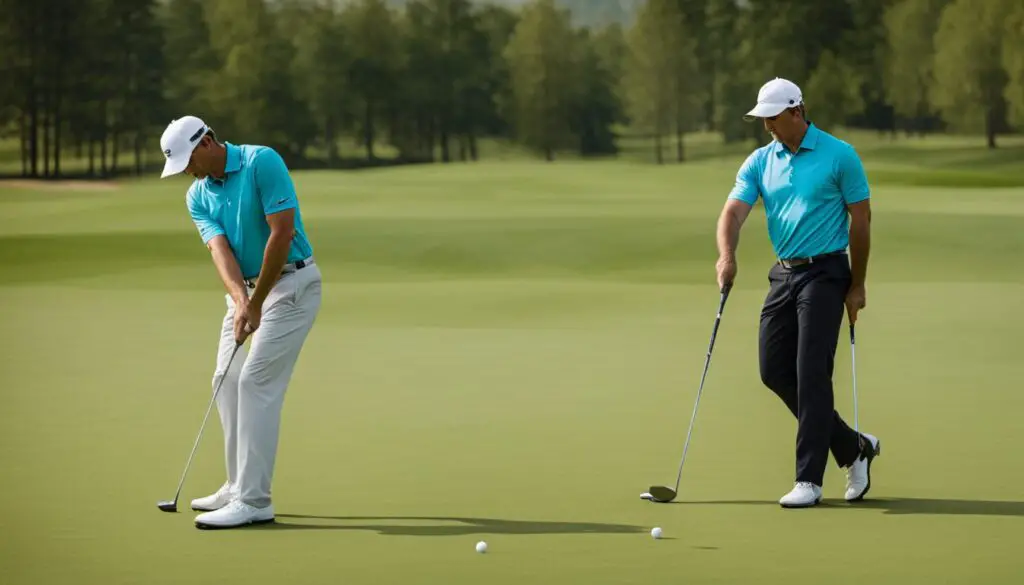Golf, often considered a game of precision and technique, requires players to continuously strive for improvement. One of the most crucial aspects of the game is mastering the golf swing. Whether you are a beginner or an experienced player, honing your golf swing can greatly enhance your performance on the course. In this comprehensive guide, we will walk you through the mechanics of the golf swing, offering valuable tips and techniques to help you improve your swing, enhance shot accuracy, and elevate your overall golfing experience.
Throughout this guide, we will delve into various key elements of the golf swing, including the grip, stance, body rotation, weight shift, swing path, and more. By focusing on each component and understanding its role in the overall swing, you will gain the knowledge and skills necessary to take your game to the next level.
Are you ready to embark on a journey towards mastering your golf swing? Let’s dive in and discover the secrets to improving your technique, enhancing consistency, and ultimately transforming your game.
Key Takeaways:
- Mastering the grip and stance are foundational to a successful golf swing.
- Body rotation and weight shift play crucial roles in generating power and distance.
- The one-line thought technique simplifies the swing and improves control.
- Visualizing and practicing the correct swing path can enhance efficiency and shot direction.
- Consistent practice and dedication are key to improving your golf swing.
The Easiest Way to Grip the Club
Mastering the correct grip is essential for a successful golf swing. It sets the foundation for control, power, and accuracy in your shots. To achieve the correct grip, start by placing the club across the base of your fingers, just above the knuckles. The club should run diagonally across the fingers, through the crease between the base of the little finger and the palm of the hand. This grip allows for better clubface control throughout the swing.
Next, wrap your fingers around the grip, making sure not to grip too tightly. The pressure should be firm but not excessive. It’s important to maintain a relaxed grip to allow for a fluid swing. The ‘squishy’ part of the thumb should be on top of the grip, providing stability and control.
Finally, check the positioning of your hands. The back of your left hand (for right-handed golfers) should face the target, while the palm of your right hand should also face the target, with the ‘V’ formed by the thumb and index finger pointing towards your trail shoulder. This grip position promotes proper wrist hinge and helps align the clubface at impact.
Grip Tips:
- Ensure the grip pressure is consistent throughout the swing.
- Practice maintaining a relaxed grip to prevent tension in your swing.
- Regularly check your grip to ensure it hasn’t shifted during the swing.
- Experiment with grip variations to find the most comfortable and effective grip for you.
Setting up your Stance
Setting up your stance correctly is crucial for a successful golf swing. Your stance forms the foundation of your swing, providing balance, stability, and proper alignment. To achieve a proper stance, follow these key steps:
- Adjust the width of your stance based on the club you are using. Generally, wider stances are recommended for longer clubs like drivers and fairway woods, while narrower stances work better for shorter clubs like wedges and irons. This helps provide stability and control throughout the swing.
- Position the ball correctly within your stance. For most shots, the ball should be placed between the middle and front of your stance. Adjusting the ball position can help ensure solid contact and the desired ball flight.
- Bend your knees slightly to maintain a balanced and athletic position. This allows for better weight transfer and rotation during the swing.
- Maintain a straight back, avoiding excessive rounding or arching. A straight back promotes proper posture and helps prevent unnecessary tension in the swing.
- Ensure your arms hang naturally, allowing for a relaxed and comfortable address position. This encourages a fluid and effortless swing.

By setting up your stance correctly, you create a solid foundation for a well-executed golf swing. Remember to practice your stance regularly and make adjustments as needed to find what works best for your game.
The Body Rotation
One of the key elements in a successful golf swing is body rotation. The rotational movement generates power and determines the distance the ball will travel. During the backswing, the golfer should focus on rotating the body to create a coiling effect. This coiling action stores energy that can be unleashed during the downswing, resulting in increased clubhead speed and longer shots.
To improve body rotation, it is helpful to visualize the motion of a diagonal line during the backswing and downswing. This imaginary line represents the path that the body should follow as it rotates. By consciously focusing on this rotational movement, golfers can develop a more consistent and powerful swing.
Incorporating exercises and drills that promote flexibility and core strength can also enhance body rotation in the golf swing. These exercises can help improve the range of motion in the shoulders and hips, allowing for a more fluid and efficient rotation. Additionally, working with a golf instructor or coach who specializes in swing mechanics can provide valuable guidance on optimizing body rotation for maximum impact on the golf ball.
The Weight Shift
When it comes to achieving power and distance in your golf swing, mastering the weight shift is essential. Shifting your weight from one side to the other helps generate the energy needed to propel the ball forward. The proper weight transfer also contributes to balance and control throughout the swing.

To execute a successful weight shift, begin by focusing on transferring your weight from your trail foot (right foot for right-handed golfers) to your lead foot. As you initiate the downswing, feel your back foot elevate and bank towards the target. This movement allows your body to rotate effectively and deliver maximum power to the ball.
Paying attention to the weight shift in your golf swing can have a significant impact on your overall performance. It helps maintain your balance, improves your timing, and allows you to unleash the full potential of your swing.
The Benefits of a Proper Weight Shift
A proper weight shift in the golf swing offers several benefits:
- Increased power and distance: By effectively transferring your weight, you can generate more energy and add distance to your shots.
- Better balance and stability: A smooth weight shift enhances your balance throughout the swing, reducing the risk of mishits and improving overall stability.
- Improved shot accuracy: When your weight is properly shifted, it allows for a consistent and repeatable swing path, resulting in improved shot accuracy.
- Enhanced clubhead speed: The weight shift contributes to the acceleration of the clubhead, leading to greater clubhead speed and more powerful shots.
By focusing on the weight shift and incorporating it into your practice routine, you can take your golf swing to the next level and enjoy better results on the course.
The One-line Thought Technique: Simplifying Your Golf Swing
When it comes to improving your golf swing, simplicity is key. The one-line thought technique offers a mental shift that can help streamline your swing mechanics and enhance your overall performance on the course. By focusing on a single straight line from the grip of the club to your trail shoulder, you can achieve a more consistent swing path and improved control of the club’s pace and direction.
Visualizing this one-line thought allows you to simplify the complexity of the golf swing and eliminate unnecessary distractions. Instead of overthinking multiple swing elements, such as hand position, hip rotation, and weight shift, you can concentrate solely on the alignment and connection between your hands and trail shoulder. This technique helps create a unified movement and promotes a smoother swing motion.
“The one-line thought technique has been a game-changer for my golf swing. By focusing on that single line, I feel more connected and in control of the club throughout the entire swing. It has helped me improve my swing plane and maintain a consistent hand focus, resulting in more accurate shots and increased confidence on the course.” – John, avid golfer
The Benefits of the One-line Thought Technique
- Consistent swing path: By aligning your hands and shoulder along a single line, you can establish a repeatable swing path, reducing the chances of slicing or hooking the ball.
- Improved swing plane: The one-line thought technique encourages a more efficient swing plane, enabling you to strike the ball cleanly and with better contact.
- Enhanced hand focus: Focusing on the alignment between your hands and trail shoulder helps maintain a steady and controlled hand position throughout the swing, resulting in improved shot accuracy.
By incorporating the one-line thought technique into your golf swing, you can simplify your approach and achieve a more consistent and controlled motion. Practice this technique during your training sessions and see how it transforms your swing mechanics and overall performance on the course.
Understanding the Proper Path
When it comes to achieving a consistent and effective golf swing, understanding the proper swing path is crucial. The swing path is the trajectory that your hands and clubhead follow during the swing. It is not a straight line but rather a slight inward and upward movement resembling a diagonal. Visualizing and practicing this correct swing path can significantly improve the efficiency of your swing, shot direction, and overall ball flight.
To reinforce the correct hand path during the swing, alignment sticks can be a helpful visual aid. Place two alignment sticks on the ground parallel to the target line, one just outside the ball and the other just inside the target. This setup will create a narrow corridor for your swing, guiding your hands along the proper path.
Remember, consistency is key when it comes to the swing path. Regular practice and repetition will help you ingrain the correct movements into your muscle memory, leading to more accurate and controlled shots on the golf course. Keep in mind that finding the right swing path for your individual swing may require some adjustments and experimentation. Consider seeking guidance from a golf instructor or coach to help you refine and perfect your swing path.

Key Takeaways
- The proper swing path in golf is a slight inward and upward movement resembling a diagonal.
- Alignment sticks can be used as a visual aid to reinforce the correct hand path during the swing.
- Consistent practice and repetition are essential for ingraining the correct swing path into muscle memory.
- Experimentation and guidance from a golf instructor or coach can help you find the right swing path for your individual swing.
Mastering your Swing
Perfecting your golf swing requires a deep understanding of the mechanics involved and consistent practice to refine your technique. By mastering the key elements of the swing, you can achieve greater consistency, power, and accuracy on the course. Here are some essential tips to help you improve your swing and become a more confident golfer.
1. Focus on the Fundamentals
To master your swing, start by ensuring that you have a solid foundation in the fundamentals. This includes mastering the grip, setting up your stance, and understanding the proper body rotation and weight shift. Practice these elements individually and then integrate them into your full swing. Pay attention to your posture, alignment, and balance, as these are crucial for generating power and maintaining control throughout the swing.
2. Utilize Training Aids
Training aids can be valuable tools in perfecting your golf swing. One effective training aid is the “Lag Shot,” which provides sensory feedback to help you develop a consistent and powerful lag in your swing. The Lag Shot helps you feel the proper sequencing of the golf swing and promotes a smooth transition from the backswing to the downswing. Incorporating training aids into your practice routine can accelerate your progress and enhance your understanding of the swing mechanics.
3. Seek Professional Guidance
Working with a golf instructor or coach can significantly accelerate your progress in mastering your swing. A professional can provide personalized guidance, identify areas for improvement, and offer specific drills and exercises tailored to your needs. They can analyze your swing mechanics, suggest adjustments, and help you develop a practice plan that focuses on your strengths and weaknesses. With their expertise and feedback, you can refine your technique more effectively and efficiently.
Remember, perfecting your golf swing is a continuous journey that requires patience, dedication, and consistent practice. Embrace the process, stay committed to your improvement goals, and be open to learning and trying new techniques. With time and effort, you can master your swing and experience improved performance and enjoyment on the golf course.
The World of Golf Literature
When it comes to golf, the literature available is as vast and varied as the sport itself. From instructional books to narrative accounts of the game’s greatest players, there is a wealth of knowledge and inspiration to be found within the pages of golf literature. Whether you’re a beginner looking for tips and techniques or a seasoned player seeking to delve deeper into the sport’s history and philosophy, there is a book out there for you.
One of the most iconic golf books is “Harvey Penick’s Little Red Book.” Penned by the legendary golf instructor Harvey Penick, this book offers valuable insights and advice on all aspects of the game. From grip and stance to swing mechanics and course management, Penick’s wisdom has helped countless golfers improve their game.
Another classic is “Ben Hogan’s Five Lessons: The Modern Fundamentals of Golf.” Hogan is widely regarded as one of the greatest golfers of all time, and his instructional book is a must-read for anyone serious about mastering the game. With detailed explanations and illustrations, Hogan breaks down the essential elements of the golf swing, providing readers with a comprehensive understanding of the mechanics behind a successful shot.
“Golf is a game of inches. The most important are the six inches between your ears.” – Bobby Jones
For those who appreciate a good golf narrative, “The Greatest Game Ever Played” by Mark Frost is a captivating account of the historic 1913 U.S. Open. The book tells the story of Francis Ouimet, a young amateur golfer who challenges the reigning British champions, Harry Vardon and Ted Ray. This underdog tale not only showcases the drama and excitement of tournament golf but also explores the enduring spirit of the game.
Whether you’re looking to improve your swing, gain insights from golfing legends, or simply enjoy a well-written story, the world of golf literature has something to offer. So, grab a book, immerse yourself in the words of the greats, and let their wisdom guide you on your golfing journey.
Exploring Golf Swing Biomechanics
Golf swing biomechanics is a fascinating field that delves into the science behind the golf swing. By understanding the intricate mechanics of the swing, golfers can optimize their technique and enhance their overall performance on the course. The study of biomechanics focuses on various aspects of the swing, including body movements, joint angles, and muscle activation patterns. This knowledge can provide valuable insights into improving swing mechanics and achieving a consistent and powerful swing.
The biomechanics of the golf swing involves analyzing the sequence of movements that occur from the start of the swing to the follow-through. Researchers use motion capture systems, force plates, and electromyography to gather data and examine the mechanics of the swing in detail. Through this analysis, they can identify key factors that contribute to a successful swing, such as the proper sequence of body rotation, weight transfer, and club positioning.
One significant aspect of golf swing biomechanics is the relationship between body movements and clubhead speed. Through studies and research, scientists have discovered that generating clubhead speed is not solely dependent on muscular strength but also on how efficiently the body moves during the swing. Improving body rotation, weight shift, and balance can help golfers maximize their clubhead speed and achieve greater distance and accuracy.
Understanding golf swing biomechanics is not just limited to professional golfers. Even recreational golfers can benefit from this knowledge by making small adjustments to their technique. By working with a golf instructor who specializes in biomechanics or studying instructional materials that highlight the science of the golf swing, golfers of all levels can enhance their understanding and execution of the swing.

Key Takeaways:
- Golf swing biomechanics is the scientific study of the body’s movements and mechanics during a golf swing.
- Understanding biomechanics can help golfers optimize their swing mechanics and improve consistency and power.
- Body rotation, weight transfer, and balance are important factors in achieving an effective golf swing.
- Knowledge of biomechanics can benefit golfers of all skill levels, from beginners to professionals.
How to Improve Your Golf Swing
Improving your golf swing is a continuous process that requires focused effort and practice. Here are some effective strategies, drills, and training techniques to help you enhance your golf swing:
- Focus on Proper Fundamentals: Start by ensuring a correct grip, posture, and alignment. These fundamental elements lay the foundation for a consistent and powerful swing.
- Incorporate Swing Drills: Incorporate specific swing drills into your practice routine to target areas that need improvement. For example, the “Pump Drill” can help you develop a smooth and controlled backswing and downswing.
- Work on Tempo and Timing: Pay attention to your tempo and timing during the swing. Practice with a metronome or count out a specific rhythm to maintain a smooth and balanced swing.
- Utilize Training Aids: Take advantage of training aids such as alignment sticks, impact bags, or weighted clubs to improve your swing mechanics and develop muscle memory.
Remember, consistency is key when it comes to improving your golf swing. Dedicate regular practice time to focus on specific aspects of your swing, and be patient with the process. With time and persistence, you will see positive changes in your swing technique and overall performance on the golf course.
The Impact of a Good Golf Swing on Your Game
A good golf swing can have a transformative effect on your game, leading to improved performance and lower scores. When you have a consistent and effective swing, you can hit longer and straighter shots with greater accuracy, making it easier to navigate the course and avoid hazards. Improved ball-striking allows you to approach each shot with confidence, knowing that you have the skill and technique to execute it successfully.
Not only does a good golf swing impact your physical performance, but it also has a significant psychological effect. A well-executed swing instills a sense of satisfaction and accomplishment, boosting your confidence and enjoyment of the game. With a smooth and powerful swing, you will experience a greater sense of control over your shots, leading to a more enjoyable and fulfilling golfing experience.
“A good swing feels effortless, almost like poetry in motion. It’s the result of countless hours of practice, fine-tuning your technique, and developing muscle memory. When you achieve that perfect swing, it’s a moment of pure bliss.”
Furthermore, a good golf swing allows for greater consistency in your game. By mastering the mechanics of your swing, you can eliminate unwanted variations that lead to inconsistent shots. Developing a repeatable swing enables you to replicate successful shots, leading to improved consistency from round to round. Consistency in your swing translates to consistency in your scores, as you can rely on your swing to deliver the desired results.
The Importance of Proper Technique
It’s important to note that the impact of a good golf swing on your game goes beyond raw power and distance. While hitting the ball far is undeniably impressive, it’s equally crucial to prioritize accuracy and shot shape. A well-executed swing allows you to shape your shots with precision, enabling you to avoid trouble and position the ball strategically.
Putting in the time and effort to develop a good golf swing pays off in many ways. Not only will you enjoy improved performance and lower scores, but you’ll also experience a deeper connection with the game. Golf is a sport that rewards dedication and skill, and mastering your swing is a key component of becoming the player you aspire to be.
Conclusion
Mastering the golf swing is an ongoing journey that can significantly improve your golf game and transform your overall playing experience. By understanding the mechanics behind a proper swing and consistently practicing the key techniques, you can unlock your full potential as a golfer.
Improving your golf game starts with mastering the fundamentals, such as the grip, stance, body rotation, and weight shift. These elements create a solid foundation for a powerful and accurate swing. By focusing on each component and refining your technique, you can enhance your control, distance, and shot accuracy.
Transforming your game requires dedication and patience. Consistent practice, coupled with a positive mindset, will help you develop muscle memory and make your swing more fluid and natural. As you continue to refine your swing, always be open to learning and seeking guidance from golf professionals or instructional resources.
Key Takeaways
Mastering the golf swing requires a combination of technique, practice, and dedication. Here are some key takeaways to help you improve your golf swing:
- Grip and Stance: Mastering the correct grip and stance is essential for a solid foundation in your swing. Focus on positioning your hands correctly on the club and maintaining a balanced and aligned stance.
- Body Rotation and Weight Shift: Incorporate proper body rotation and weight shift in your swing to generate power and consistency. Visualize a coiling effect during the backswing and practice transferring weight smoothly from your trail foot to your lead foot.
- One-Line Thought Technique: Simplify your swing by focusing on a straight line from the grip of the club to your trail shoulder. This technique helps enhance swing path and club control.
- Correct Swing Path: Visualize and practice a slightly inward and upward swing path to optimize your swing efficiency, shot direction, and ball flight. Use alignment sticks as visual aids to reinforce the correct hand path.
- Consistent Improvement: Improving your golf swing requires consistent practice and repetition of drills. Break down the swing into manageable parts and focus on one element at a time. With dedication and perseverance, you can achieve a reliable and effective swing.
Remember, mastering the golf swing is a journey that takes time and effort. Embrace the challenges, stay committed to improvement, and enjoy the process. By implementing these key takeaways, you can enhance your golf swing and take your game to the next level.

Frequently Asked Questions about Mastering the Golf Swing
As you embark on your journey to master the golf swing, you may have some burning questions about technique, tips, and common challenges. To help you navigate through the intricacies of the golf swing, we’ve compiled a list of frequently asked questions (FAQs) to provide you with the answers you need to improve your swing.
Common Golf Swing Questions
- What is the most important aspect of a golf swing?
- How can I improve my swing tempo?
- Should I keep my head down during the swing?
- How can I generate more power in my swing?
The grip and stance are crucial foundations for a solid golf swing. By mastering the correct grip and establishing a balanced stance, you can set yourself up for success.
Consistency and rhythm are key to a smooth swing tempo. Practice with a metronome or count in your head to maintain a consistent pace throughout your swing.
While it’s important to keep your eye on the ball, keeping your head down too rigidly can restrict your rotation and affect your balance. Instead, focus on maintaining a steady gaze on the ball throughout your swing.
Power comes from a combination of proper body rotation, weight transfer, and timing. Focus on generating a full shoulder turn and transferring your weight smoothly from your back foot to your front foot to maximize power.
Golf Swing Queries
- What are some effective drills to improve my swing?
- How do I fix a slice in my golf swing?
- Are there any mental strategies to improve my golf swing?
- How can I maintain consistency in my golf swing?
There are various drills you can incorporate into your practice routine to refine your swing. From mirror drills to impact bag drills, working on specific aspects of your swing can help you identify and correct any flaws.
A slice is a common issue that results in the ball curving to the right for right-handed golfers. To correct a slice, focus on improving your grip, ensuring a square clubface at impact, and promoting an inside-out swing path.
Golf is as much a mental game as it is a physical one. Utilize visualization techniques to imagine and feel the desired swing motion, and practice positive self-talk to enhance confidence and focus during your swing.
Consistency comes with practice and repetition. Create a consistent pre-shot routine, pay attention to your posture and alignment, and work on ingraining the proper swing mechanics through deliberate practice.
By addressing these common golf swing questions, we hope to provide you with the knowledge and insights to enhance your understanding of the golf swing and take your game to new heights. Remember, mastering the golf swing is a continuous journey, so embrace the process and enjoy the improvements you’ll see along the way!

Stay on Your Path to Golfing Success
Embarking on the journey to master your golf swing takes dedication, perseverance, and a passion for improvement. With each swing, you have the opportunity to refine your technique and elevate your golfing experience. Whether you’re a beginner or a seasoned player, the path to golfing success is an ongoing adventure.
To improve your golf swing, it’s crucial to embrace the challenges and commit to consistent practice. Focus on the fundamentals, such as mastering your grip, perfecting your stance, and optimizing your body rotation. By understanding the mechanics of the swing and honing your skills, you’ll see progress and enhanced performance on the course.
Remember, your golfing journey is unique to you. It’s not just about achieving the perfect swing, but also about enjoying the process and embracing the lessons learned along the way. Each swing is an opportunity to learn, grow, and discover new aspects of your game. Embrace the joy of the game, stay positive, and keep pushing yourself to new heights of golfing success.
So, as you step onto the green, hold onto your determination and passion. Trust in your abilities, stay focused on improvement, and enjoy the incredible journey that golf offers. With time, practice, and a resilient mindset, your efforts will pay off, leading you to golfing success and a swing that reflects your dedication and hard work.
FAQ
How do I improve my grip on the golf club?
To improve your grip, ensure that the back of your left hand and the palm of your right hand (for right-handed golfers) face the target. Wrap your hands around the grip, keeping the ‘squishy’ part of your thumb on top and making sure the first two knuckles are visible. The crease between your thumb and index finger should point towards your trail shoulder (right shoulder for right-handed golfers).
What should I keep in mind when setting up my stance?
For a well-adjusted stance, vary the width of your stance based on the club you are using – wider stances for longer clubs and narrower stances for shorter clubs. Position the ball between the middle to front of your stance. Maintain flexed knees, a straight back, and a natural arm position.
How can I improve body rotation in my golf swing?
During the backswing, focus on rotating your body to create a coiling effect. Visualize a diagonal line and follow its motion during the backswing and downswing. This can help improve rotational movement and consistency in your swing.
Why is weight shift important in a golf swing?
Shifting weight from your trail foot to your lead foot is essential for generating power and distance in your swing. Practice transferring your weight and ensure that your back foot elevates and banks towards the target during the weight shift.
What is the one-line thought technique and how can it help my swing?
The one-line thought technique is a mental shift that simplifies your golf swing. By focusing on a single straight line from the grip of the club to your trail shoulder, you can achieve a more consistent swing path and improved control over the club’s pace and direction.
How can I visualize and practice the proper swing path?
The proper swing path in golf is not a straight line but a slight inward and upward movement resembling a diagonal. Visualize and practice this path to improve your swing efficiency, shot direction, and ball flight. Alignment sticks can be used as a visual aid to reinforce the correct hand path during the swing.
How can I master my own golf swing?
Mastering your golf swing involves understanding and integrating the right mechanics for your swing. Emphasizing the importance of training aids like the “Lag Shot” can provide sensory feedback for refining your swing technique. Continual practice and dedication are key to perfecting your swing and achieving consistency and accuracy.
Are there any recommended golf books to enhance my golfing knowledge?
Yes, there are numerous golf books available that offer insights, inspiration, and instruction. Some notable titles include “Harvey Penick’s Little Red Book,” “Ben Hogan’s Five Lessons,” and “The Greatest Game Ever Played.”
What is golf swing biomechanics and how can it help me improve my swing?
Golf swing biomechanics refers to the scientific study of the body’s movements and mechanics during a golf swing. Understanding the biomechanics can help optimize your swing mechanics, improving consistency and power. Proper body rotation, weight transfer, and balance are important factors in achieving an effective golf swing.
How can I improve my golf swing?
Improving your golf swing requires practice and dedication. Focus on one element of the swing at a time and break it down into manageable parts. Consistent practice and repetition of golf swing drills can help ingrain the correct movements and develop a reliable and effective swing.
What impact does a good golf swing have on my game?
A good golf swing can have a profound impact on your game. With a consistent and effective swing, you can hit longer and straighter shots, leading to improved performance and lower scores. A good swing also boosts confidence and enjoyment of the game.
What are the key takeaways from this guide?
The key takeaways include mastering the grip and stance, understanding body rotation and weight shift, utilizing the one-line thought technique, visualizing and practicing the correct swing path, and consistently working on improving your golf swing.
How can I stay on the path to golfing success?
Continued dedication and practice are essential to stay on the path to golfing success. Embrace the challenges, keep learning, and stay committed to improving your golf swing. With perseverance and a positive mindset, you can achieve your goals and reach new heights in your golfing journey.
